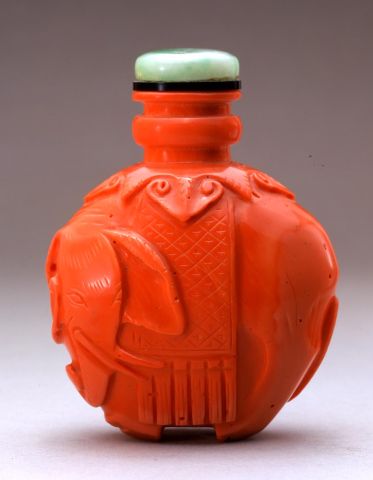
Bottle ID: 00169
CORAL, IMITATION, CARVED IN ELEPHANT FORM
Date: 1750-1820
Height: 64 mm
Glass, of rounded bulbous form, molded and carved in the form of a caprisoned elephant, the tasseled howdah cloth incised with a brocade design beneath a ruyi head collar, upon which rests a vessel that forms the neck of the bottle, which stands on four feet, the body of opaque coral-red tones, in imitation of coral.
Possibly Imperial, attributed to the Palace Workshops, Beijing.
Similar Examples:
Crane Collection nos. 220 and 256.
Crane Collection nos. 210 and 326
Hui, Humphrey K. F. and Christopher C. H. Sin. An Imperial Qing Tradition - Chinese Snuff Bottles from the Collection of Humphrey K. F. Hui and Christopher C. H. Sin, 1994, p. 118, no. 145.
Provenance:
Clare Lawrence Ltd.
The Monimar Collection
Robert Hall
Exhibited:
Annual Convention ICSBS Toronto, October 2007
It has been suggested that 'elephant' form glass bottles are rare but in fact, they are relatively common and indeed the Crane Collection houses three of them in glass. 'Elephant' form bottles occur in colors of opaque yellow, red, blue and 'coral' as monochrome colors and, more rarely, as overlay glass combinations such as green overlaid on caramel and red overlaid on snowflake glass.
The elephant with a vessel or vase on its back forms a rebus, taiping youxiang, for the wish for stability and peace for both the Emperor and outside the Palace, for his people. There is a further level of meaning with the bottle shape combined with the ruyi head collar forming the rebus, ping'an ruyi, meaning: 'May there be peace and may all your wishes come true'.
The presence of the elephant at Court was a popular sight, not simply because of its ultilitarian value, but also because of what it symbolized. This is clearly shown in the depiction of the beast, often in pairs, on works of art and in sculptural form.
< Back to full list
 English
English 中文
中文